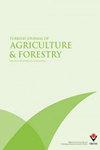不同土壤镉浓度对绿豆植物生长、植物矿物质平衡和抗氧化防御均有不利影响
IF 3
2区 农林科学
Q1 AGRONOMY
引用次数: 0
摘要
土壤重金属污染已经成为一个全球性的大问题。金属进入食物链,对植物、动物和人类造成问题。本研究旨在评价不同镉浓度对辐射维纳生长、生理、矿质营养和产量特性的影响。增长基金的变化具有统计意义,并与Cd剂量的增加直接相关。不同浓度镉对试验植株叶绿素、氨基酸、可溶性蛋白和总可溶性糖含量等生化指标的影响显著(p≤0.05)。与对照相比,Cd浓度越高,茎部和根部钙含量越低,呈现Cd 40 > Cd 30 > Cd 20 > Cd 10的趋势。与其他Cd水平相比,茎部和根部钾(K +)含量受Cd 10的影响较小。这些酶含量在较高Cd浓度(Cd 40)下升高最大,随着Cd水平的降低,这些抗氧化剂的浓度下降(Cd 30 > Cd 20 > Cd 10 > Cd 0)。与对照相比,随着Cd浓度的增加,单株种子产量和千粒重显著(p≤0.05)降低。Cd 10处理对籽粒产量和籽粒质量影响较小,其次是Cd 20和Cd 30处理。在此基础上,我们建议将研究重点明确放在Cd危害的机理上。此外,应该探索植物中的靶酶或代谢物,以用于开发耐hm作物品种。本文章由计算机程序翻译,如有差异,请以英文原文为准。
Different doses of cadmium in soil negatively impact growth, plant mineral homeostasis and antioxidant defense of mung bean plants
: Heavy metal (HM) pollution of soil has become a gigantic issue across the globe. Metals enter the food chain and cause problems in plants, animals, and humans. We performed this work to evaluate the impacts of different cadmium (Cd) levels on growth, physiology, mineral nutrition, and yield attributes of Vigna radiata. Changes in growth fund are statistically significant and directly linked with an increase in Cd doses. Various concentrations of cadmium exhibited significant (p ≤ 0.05) vicissitudes in biochemical parameters such as in the contents of chlorophyll, amino acids, soluble proteins, and total soluble sugars in experimental plants. The shoot and root calcium contents were highly reduced by higher concentrations of Cd in the following trend Cd 40 > Cd 30 > Cd 20 > Cd 10 than the control. Likewise, shoot and root potassium (K + ) contents were less influenced by Cd 10 as compared to other levels of Cd. The elevation in these enzymatic contents was maximum under the higher concentration of Cd (Cd 40 ), and with the decreasing Cd level, a decline in concentrations of these estimated antioxidants was recorded (Cd 30 > Cd 20 > Cd 10 > Cd 0 ). A significant (p ≤ 0.05) reduction in seed yield per plant and thousand seed weight was estimated with the increase in the concentration of Cd as compared to the control. The seed yield and their weights were less influenced in Cd 10 treated plants followed by Cd 20 and then Cd 30 . On the basis of the reported findings, our recommendation is to conduct research with an explicit focus on the mechanistic elucidation of damages caused by Cd. Additionally, target enzymes or metabolites in plants should be explored for use in the development of HM-tolerant crop varieties.
求助全文
通过发布文献求助,成功后即可免费获取论文全文。
去求助
来源期刊
CiteScore
4.20
自引率
6.90%
发文量
42
审稿时长
12 months
期刊介绍:
The Turkish Journal of Agriculture and Forestry is published electronically 6 times a year by the Scientific and Technological Research Council of Turkey (TÜBİTAK).
It publishes, in English, full-length original research papers and solicited review articles on advances in agronomy, horticulture, plant breeding, plant protection, plant molecular biology and biotechnology, soil science and plant nutrition, bionergy and energy crops, irrigation, agricultural technologies, plant-based food science and technology, forestry, and forest industry products.

 求助内容:
求助内容: 应助结果提醒方式:
应助结果提醒方式:


